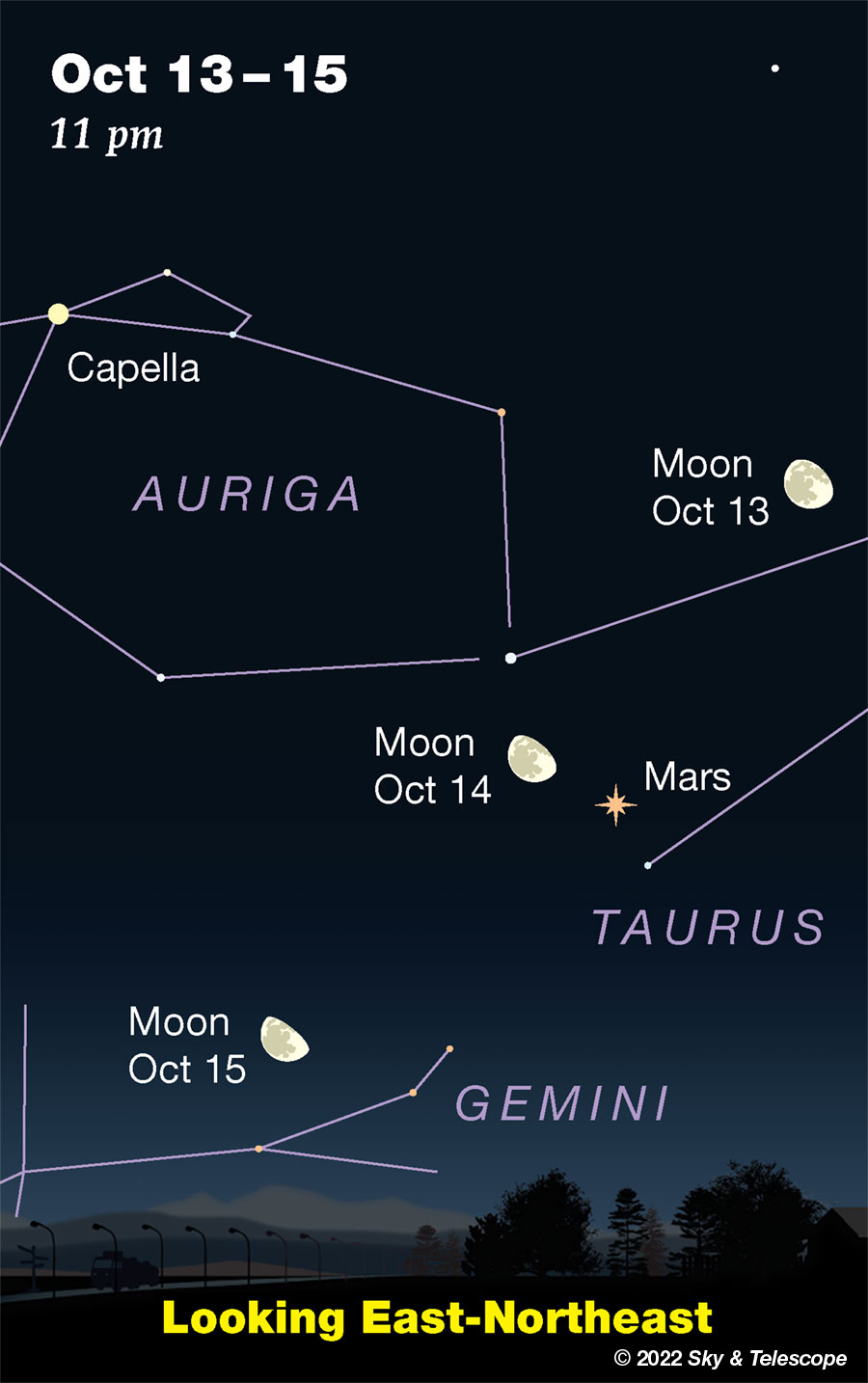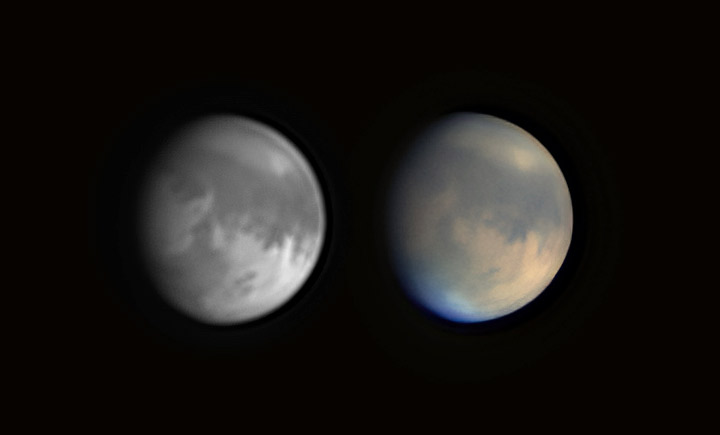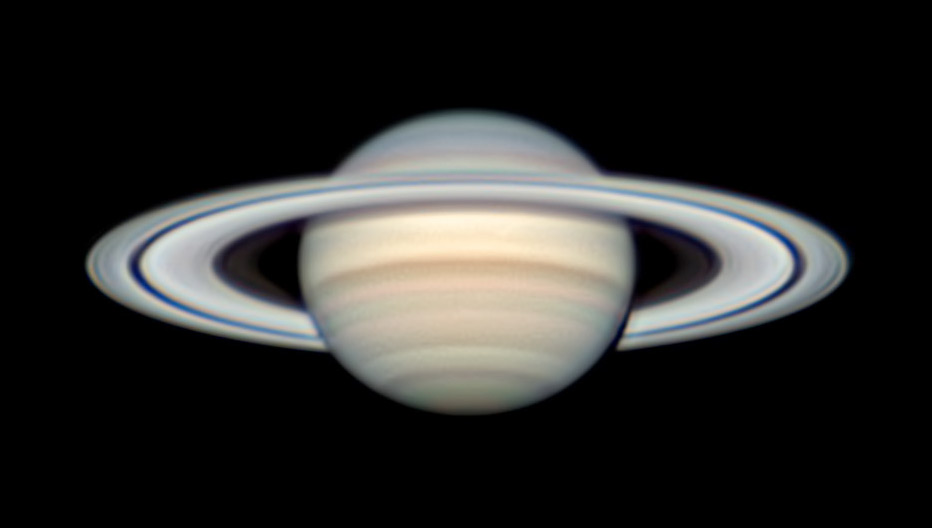FRIDAY, OCTOBER 14
■ The waning gibbous Moon rises after about 9 p.m. tonight. Once it's up, look to its right or lower right for bright Mars. By 11 they're nice and high, as shown below. They're both between the horntip stars of Taurus: Beta Tauri, magnitude 2, and Zeta Tauri, mag 3.

Once again, the Moon and an outer planet demonstrate that they shine together on opposite sides of their opposition dates. The Moon was full (at opposition) last Sunday, while Mars will reach opposition December 8th.
SATURDAY, OCTOBER 15
■ Now that it's mid-October, Deneb has replaced Vega as the zenith star after nightfall (for skywatchers at mid-northern latitudes). Accordingly, Capricornus has replaced Sagittarius as the zodiacal constellation low in the south.
Vega, meanwhile, is still that brightest star high in the west. Less high in the southwest look for Altair, not quite as bright.
Just upper right of Altair, by a finger-width at arm's length, is little orange Tarazed. Down from Tarazed runs the dimmer stick-figure backbone of the constellation Aquila, the Eagle.
SUNDAY, OCTOBER 16
■ This is the time of year when, after nightfall, Cassiopeia stands on end halfway up the northeastern sky — and when, off to its left in the north, the dim Little Dipper extends leftward from Polaris. The Little Dipper's two brightest stars (2nd magnitude) are Polaris, the end of its handle due north, and Kochab, the lip of its bowl about a fist and a half to Polaris's left.
MONDAY, OCTOBER 17
■ Tonight Mars shines right on the line between the horntip stars of Taurus. Look east once Mars is well up, around about 10 or 11 pm. Mars glares at magnitude –0.9, Beta Tauri above it is mag 1.6, and Zeta Tauri is much closer below Mars at mag 3.0.
■ Last-quarter Moon (exact at 1:15 p.m. EDT). The Moon rises around midnight in dim Cancer. Above it will be Pollux and Castor. Much higher above you'll find bright Capella.
TUESDAY, OCTOBER 18
■ Cassiopeia has clusters! Lots of open clusters. Some of them are pick-uppable in good binoculars, with care and effort, in this dark-of-the-Moon week. Two you may never have tried for are NGC 129 and NGC 225, hardly more than 2° apart near Cassiopeia's W pattern.
NCG 129 is nearly halfway from Beta to Gamma Cas. It's magnitude 6.5 in total but loosely scattered across about ¼° of sky. It's centered ¼° north of a 6th-magnitude star, the fainter star of two in line with Beta and Gamma. The cluster's brightest points are only 9th magnitude, so expect just a very subtle, diffuse glow even in a dark sky. It's 5,300 light-years away.
NGC 225 is 7th mag but friendlier in my opinion. "To me," writes Matt Wedel, "the stars at the cluster's center look like a cup or chalice, with fainter lights glittering within." The cup is open to the north and 0.2° across its top. But the cup's stars are mostly 9th or 10th magnitude, so a telescope at low power may be in order. This cluster is about half as distant, some 2,600 light-years out.
See the finder charts for both with Matt's column in the October Sky & Telescope, page 43.
WEDNESDAY, OCTOBER 19
■ Vega is the brightest star very high toward the west these evenings. Face west and look way up.
To Vega's right or lower right by 14° (nearly a fist and a half at arm's length), look for Eltanin, the nose of Draco the Dragon. The rest of Draco's fainter, lozenge-shaped head is a little farther behind. Binoculars will help through the moonlight; Draco's head is about the width of a typical binocular's field of view.
Draco always eyes Vega as they wheel around the sky.
The main stars of Vega's own constellation, Lyra — faint at 3rd and 4th magnitude — extend to Vega's left by half as far as the distance from Vega to Eltanin. Again, binoculars will help.
THURSDAY, OCTOBER 20
■ Orionids in the dark. The pre-dawn sky is moonless Friday morning, offering a good chance to catch some meteors of the Orionid shower — debris from Halley's Comet. The shower's origin point (radiant) will be highest in the hour before the first sign of dawn, so this is when the shower will appear most active. You might see 5 to 20 meteors per hour then depending on your light p0llution.
The best direction to watch is your darkest direction, probably overhead. The radiant is in Orion's Club under the feet of Gemini. That's where the meteors will appear to be directed away from. The shower will be less active for a morning or two before and after. See the October Sky & Telescope, page 48.
FRIDAY, OCTOBER 21
■ As autumn advances, the Great Square of Pegasus floats ever higher after dark. Face east-southeast in early evening and look very high. The Square is standing on one corner. Your fist at arm's length fits inside it.
Look at its four stars carefully. They're 2nd and 3rd magnitude. Three are white, one is a "red" giant (actually orange-yellow). Can you tell which with the naked eye? Binoculars easily reveal that it's the top one, Beta Pegasi or Scheat. It's type M2.5, an old, evolved star of about 2.1 stellar masses, about 196 light-years away. See Meet Scheat, the Peak of Pegasus.
Away from the Great Square's left corner runs the main line of Andromeda: three 2nd-magnitude stars about as bright as those of the Square and spaced similarly far apart. The three include the Square's corner. This whole dipper-shaped pattern was named the Andromegasus Dipper by the late Sky & Telescope columnist George Lovi — to accompany the Big and Little Dippers, the Milk Dipper of Sagittarius (nowadays usually subsumed into the Teapot), and the tiny dipper pattern of the Pleiades.
SATURDAY, OCTOBER 22
■ Spot bright Altair high in the southwest soon after dark. Brighter Vega is far to its right.
Above Altair lurk two distinctive little constellations: Delphinus the Dolphin, hardly more than a fist at arm's length to Altair's upper left, and smaller, fainter Sagitta the Arrow, slightly less far to Altair's upper right. Sky too bright? Use binoculars!
This Week's Planet Roundup
Mercury is starting to come down from its best morning apparition of 2022. Look for it in early dawn, low almost due east. It's bright at about magnitude –1.0. Don't confuse it with twinklier Arcturus rising off to its left, low in the east-northeast.
Venus is hidden in conjunction with the Sun.
Mars, magnitude –0.9 in eastern Taurus, clears the east-northeast horizon around 9 p.m. or so and gains altitude for the rest of the night. Mars this week is passing between the horntip stars of Taurus, Beta and Zeta Tauri. It's exactly between them on the night of Monday the 17th. Watch it creep eastward from night to night.
Orange Aldebaran sparkles to Mars's upper right, by about a fist and a half, at magnitude +0.9. Which of the two seems to you to have the slightly deeper tint?
A similar distance above Aldebaran are the Pleiades.
In a telescope, Mars grows from 13 to 14 arcseconds wide this week. The best time to examine it is when it's very high in the hours before dawn. Mars is well on its way to reaching 17.2 arcseconds diameter around December 1st, when it's closest to Earth.

Dark areas near center with downward prongs are Margaritifer Sinus and Aurorae Sinus. Lower left of Margaritifer Sinus, dark Oxia Palus has grown large and joined with the Niliacus Lacus / Mare Acidalium region below. Walker uses a Player One Astronomy Uranus-C video camera on a 12.5-inch Newtonian reflector.
Jupiter is a nearly a month past opposition. As twilight fades, spot it blazing at magnitude –2.8 in the east-southeast in dim Pisces. It stands highest in the south around 11 or midnight.
In a telescope Jupiter is still 48 arcseconds wide across its equator, almost the largest it can appear; Jupiter is close to the perihelion of its 12-year orbit around the Sun.

Saturn, magnitude +0.6 in dim Capricornus, crosses the south in early evening. It's about four fists to the right of Jupiter during and after the end of twilight. It's lower right of Jupiter as evening grows late. Saturn transits the meridian about an hour after complete dark.

The gray band seen on the globe along the inner edge of the rings is not a belt or a shadow but the semi-transparent C ring.
Uranus, magnitude 5.6 in Aries, is up in the east in good binocular or telescope view by late evening. See the Uranus finder charts in the November Sky & Telescope, page 49.
Neptune, magnitude 7.8 at the Aquarius-Pisces border, is high in the evening about 8° west of Jupiter. See the Neptune finder charts in the September Sky & Telescope, page 49.
All descriptions that relate to your horizon — including the words up, down, right, and left — are written for the world's mid-northern latitudes. Descriptions and graphics that also depend on longitude (mainly Moon positions) are for North America.
Eastern Daylight Time, EDT, is Universal Time minus 4 hours. (Universal Time is also called UT, UTC, GMT or Z time.)
Want to become a better astronomer? Learn your way around the constellations. They're the key to locating everything fainter and deeper to hunt with binoculars or a telescope.
This is an outdoor nature hobby. For an easy-to-use constellation guide covering the whole evening sky, use the big monthly map in the center of each issue of Sky & Telescope, the essential magazine of astronomy.
Once you get a telescope, to put it to good use you'll need a detailed, large-scale sky atlas (set of charts). The basic standard is the Pocket Sky Atlas (in either the original or Jumbo Edition), which shows stars to magnitude 7.6.

Next up is the larger and deeper Sky Atlas 2000.0, plotting stars to magnitude 8.5; nearly three times as many. The next up, once you know your way around, are the even larger Interstellarum atlas (stars to magnitude 9.5) or Uranometria 2000.0 (stars to magnitude 9.75). And be sure to read How to Use a Star Chart with a Telescope. It applies just as much to charts on your phone or tablet as to charts on paper.
You'll also want a good deep-sky guidebook. A beloved old classic is the three-volume Burnham's Celestial Handbook. An impressive more modern one is the big Night Sky Observer's Guide set (2+ volumes) by Kepple and Sanner.
Can a computerized telescope replace charts? Not for beginners, I don't think, and not on mounts and tripods that are less than top-quality mechanically, meaning heavy and expensive. And as Terence Dickinson and Alan Dyer say in their Backyard Astronomer's Guide, "A full appreciation of the universe cannot come without developing the skills to find things in the sky and understanding how the sky works. This knowledge comes only by spending time under the stars with star maps in hand."
![]() Audio sky tour. Out under the evening sky with your
Audio sky tour. Out under the evening sky with your
earbuds in place, listen to Kelly Beatty's monthly
podcast tour of the heavens above. It's free.
"The dangers of not thinking clearly are much greater now than ever before. It's not that there's something new in our way of thinking, it's that credulous and confused thinking can be much more lethal in ways it was never before."
— Carl Sagan, 1996
"Facts are stubborn things."
— John Adams, 1770
 5
5









Comments
Rod
October 15, 2022 at 9:55 pm
I did get out this evening and enjoy Jupiter, Neptune, and Saturn. Observed 1900-2030 EDT/2300-0030 UT. Moon rise 2212 EDT in Gemini, waning gibbous. Last Quarter Moon 17-Oct-2022 1715 UT. Jupiter's Great Red Spot transit at 0125 UT 16-Oct-2022 or 2125 EDT 15-Oct. I could see the Great Red Spot at 71x and 129x using #58 Green filter with my 90-mm refractor telescope. 129x was better view with cloud banding in north region and southern region of Jupiter along with the NEB and SEB. 3 Galilean moons visible. I tracked down Neptune with the Telrad and could see its distinct blue dot at 71x, nice color contrast compared to Jupiter or Saturn without filters. Stellarium shows Jupiter and Neptune 7-degrees 58 arcminute angular separation or just about 8-degrees apart. Saturn provided some excellent observing at 129x without filters. I could see the Cassini division, some cloud banding in the northern area, and a tiny slice of shadow on the rings. Titan moon stood out easily and Rhea visible but fainter. I did observe one satellite near 1920 EDT while watching Saturn at 71x with true FOV a bit more than 1-degree, perhaps 5th magnitude. The satellite crossed the eyepiece field while I observed. Shortly after I noticed a polar orbiting satellite descending south passing by Aquila and Altair, perhaps 3rd magnitude. An enjoyable evening. I used 90-mm refractor telescope with TeleVue 14-mm Delos, TeleVue 1.8x Barlow lens, and TeleVue 32-mm plossl for low power, wider field views at 31x. Skies clear, temperature 13C with light south winds.
You must be logged in to post a comment.
Rod
October 17, 2022 at 8:29 am
October 15, 2022 at 9:55 pm I did get out this evening and enjoy Jupiter, Neptune, and Saturn. Observed 1900-2030 EDT/2300-0030 UT. Moon rise 2212 EDT in Gemini, waning gibbous. Last Quarter Moon 17-Oct-2022 1715 UT. Jupiter's Great Red Spot transit at 0125 UT 16-Oct-2022 or 2125 EDT 15-Oct. I could see the Great Red Spot at 71x and 129x using #58 Green filter with my 90-mm refractor telescope. 129x was better view with cloud banding in north region and southern region of Jupiter along with the NEB and SEB. 3 Galilean moons visible. I tracked down Neptune with the Telrad and could see its distinct blue dot at 71x, nice color contrast compared to Jupiter or Saturn without filters. Stellarium shows Jupiter and Neptune 7-degrees 58 arcminute angular separation or just about 8-degrees apart. Saturn provided some excellent observing at 129x without filters. I could see the Cassini division, some cloud banding in the northern area, and a tiny slice of shadow on the rings. Titan moon stood out easily and Rhea visible but fainter. I did observe one satellite near 1920 EDT while watching Saturn at 71x with true FOV a bit more than 1-degree, perhaps 5th magnitude. The satellite crossed the eyepiece field while I observed. Shortly after I noticed a polar orbiting satellite descending south passing by Aquila and Altair, perhaps 3rd magnitude. An enjoyable evening. I used 90-mm refractor telescope with TeleVue 14-mm Delos, TeleVue 1.8x Barlow lens, and TeleVue 32-mm plossl for low power, wider field views at 31x. Skies clear, temperature 13C with light south winds.
You must be logged in to post a comment.
Rod
October 19, 2022 at 11:48 pm
I was out this evening looking in Cassiopeia 🙂 Observed 2100-2230 EDT. Waning crescent Moon rise in Leo near 0206 EDT. Some excellent views tonight using my 10-inch Newtonian with TeleVue 35-mm PO at 34x. Low power, wide field observations. My favorites were M31 and NGC 869 and NGC 884, the Double Cluster in Perseus. Great views using the 2-inch eyepiece. Some dust lanes apparent in M31 and its two companions visible (M32 and M110). M33 looked more like a large amorphous shape. NGC 129 was a good open cluster to enjoy in Cassiopeia as well as NGC 457, NGC 663, and NGC 664. NGC 457 looks like an owl with wings spread. Perhaps an angry owl 🙂 7 open clusters viewed tonight at low power, wide field and 4 galaxies. M31, M32, M110, and M33.
You must be logged in to post a comment.
Rod
October 19, 2022 at 11:56 pm
Oops, NGC 663 and NGC 654 in Cassiopeia. Not NGC 664. Both nice open clusters to see tonight.
You must be logged in to post a comment.
mary beth
October 20, 2022 at 12:25 pm
Very nice reports Rod! Glad you are able to enjoy the beautiful October skies. Mars is incredible! I was surprised how far north it is, wasn’t expecting that.
Trying to enjoying The Ghost the Departed Summer Suns before it disappears for the winter. I really like how it twinkles so brightly from early spring to later autumn, such a lovely color too.
You must be logged in to post a comment.
You must be logged in to post a comment.